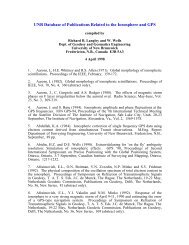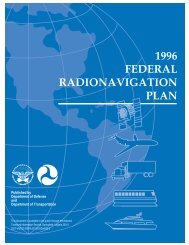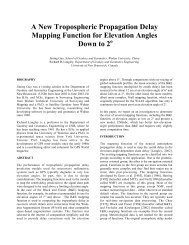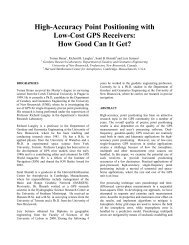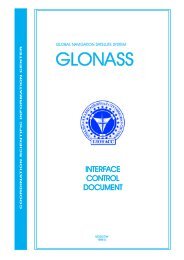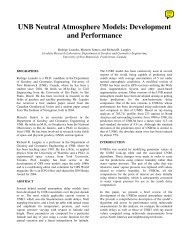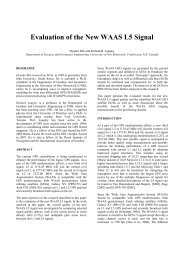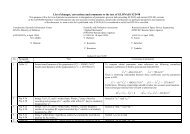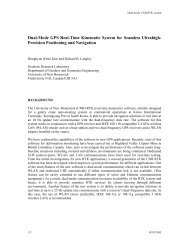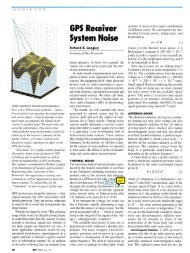activity, plasmaspheric tails are formed that extend away down to the i<strong>on</strong>osphere, affecting Earthcommunicati<strong>on</strong> (Forster and Jakowski, 2000).Due to the different molecules and atoms in the atmosphere and their differing rates of absorpti<strong>on</strong>, aseries of distinct regi<strong>on</strong>s or layers of electr<strong>on</strong>s exist. These are denoted by letters D, E, F1, F2 andare usually referred to as the bottom side i<strong>on</strong>osphere as shown in Figure 2.3. The porti<strong>on</strong> of theupper atmosphere between the F2 layer and the upper boundary is termed the topside i<strong>on</strong>osphere. Itis in the F2 layer where the maximum electr<strong>on</strong> density usually occurs as a result of the combinedeffect of <str<strong>on</strong>g>solar</str<strong>on</strong>g> EUV radiati<strong>on</strong> and the increase of neutral atmospheric density as the altitudedecreases.The maximum frequency at which a radio wave would be reflected from an i<strong>on</strong>ospheric layer iscalled the critical plasma frequency of the particular layer and is denoted by foD, foE, foF1, andfoF2 according to the designati<strong>on</strong> of the i<strong>on</strong>ospheric layer. The square of a critical frequency islinearly proporti<strong>on</strong>al to the maximum electr<strong>on</strong> density of the individual layer, denoted by NmD,NmE, NmF1 and NmF2 respectively. The changes in foD, foE and foF1 are in phase with <str<strong>on</strong>g>solar</str<strong>on</strong>g>variati<strong>on</strong> and foF2 is in anti-phase (Komjathy, 1997). The existence of the D, E, and F1 layers seemsto be primarily c<strong>on</strong>trolled by the <str<strong>on</strong>g>solar</str<strong>on</strong>g> zenith angle showing a str<strong>on</strong>g diurnal, seas<strong>on</strong>al and latitudinalvariati<strong>on</strong>. The diurnal variati<strong>on</strong> of the D, E, and F1 layers also implies that they tend to vanish orgreatly reduce in size at night. The F1 layer disappears in winter when the <str<strong>on</strong>g>solar</str<strong>on</strong>g> zenith angle ishigher than in summer, at which the F1 layer is c<strong>on</strong>sistently present. The critical frequency of thelayers follows the 11-year <str<strong>on</strong>g>solar</str<strong>on</strong>g> <str<strong>on</strong>g>cycle</str<strong>on</strong>g> variati<strong>on</strong> caused by the change in the intensity of <str<strong>on</strong>g>solar</str<strong>on</strong>g>radiati<strong>on</strong>. A brief descripti<strong>on</strong> of individual i<strong>on</strong>ospheric layers is given below. For furtherinformati<strong>on</strong> the reader is referred to Davies (1990), McNamara (1990) and Stubbe (1996).21
2.3.1 The D layerThe D layer is the lowest porti<strong>on</strong> of the i<strong>on</strong>osphere, extending in height from ~50 to ~90 km abovethe Earth’s surface. The primary source of i<strong>on</strong>izati<strong>on</strong> in this layer is cosmic rays (Davies, 1990;Stubbe, 1996), which manifest in a <str<strong>on</strong>g>solar</str<strong>on</strong>g> <str<strong>on</strong>g>cycle</str<strong>on</strong>g> variati<strong>on</strong> in the D layer’s electr<strong>on</strong> density. Duringnighttime, the electr<strong>on</strong>s may become attached to atoms and molecules, forming negative i<strong>on</strong>s thatcause the D layer to disappear. During daytime, as a result of background <str<strong>on</strong>g>solar</str<strong>on</strong>g> radiati<strong>on</strong>,photoi<strong>on</strong>izati<strong>on</strong> occurs causing the recovery of the D layer electr<strong>on</strong> densities. In principle, theelectr<strong>on</strong> density in the D regi<strong>on</strong> increases m<strong>on</strong>ot<strong>on</strong>ically with altitude, and a typical daytimeelectr<strong>on</strong> number density at 90 km is ~ 10 10 m -3 . The uppermost D layer regi<strong>on</strong> – above 80 km ismainly dominated by+NO and+O2i<strong>on</strong>s, whereas in the lower regi<strong>on</strong> complex positively chargedwater cluster i<strong>on</strong>s, and also negative i<strong>on</strong>s, play a significant role. The latter is often referred to asthe C layer (Davies, 1990).2.3.2 The E layerThe i<strong>on</strong>osphere in the altitude range from about 90 km to about 140 km is termed the E regi<strong>on</strong>,which has a typical peak electr<strong>on</strong> density of ~ 10 11 m -3 occurring at an altitude of approximately 105km. The E regi<strong>on</strong> is characterized by molecular i<strong>on</strong>s and chemical processes and the reacti<strong>on</strong>between charged particles are not important. The primary source of i<strong>on</strong>izati<strong>on</strong> is <str<strong>on</strong>g>solar</str<strong>on</strong>g> X-rayemissi<strong>on</strong>, resulting in electr<strong>on</strong> densities showing distinct <str<strong>on</strong>g>solar</str<strong>on</strong>g> <str<strong>on</strong>g>cycle</str<strong>on</strong>g>, seas<strong>on</strong>al and diurnal variati<strong>on</strong>.In particular, the molecularof N2and O2. Most of theoxygen. As a result,+O2and+N2and+O2i<strong>on</strong>s are the primary i<strong>on</strong>izati<strong>on</strong> products of photoi<strong>on</strong>isati<strong>on</strong>+N2i<strong>on</strong>s are lost in rapid sec<strong>on</strong>dary reacti<strong>on</strong>s with atomic and molecular+NO are the main molecular i<strong>on</strong>s. Furthermore, most of+O2i<strong>on</strong>s reactwith N2to form NO and+NO , rather than dissociatively recombining with electr<strong>on</strong>s. As ac<strong>on</strong>sequence, the+NO leads to neutralizati<strong>on</strong> (Stubbe, 1996; Shetti, 2006).22
- Page 1 and 2: SOLAR CYCLE EFFECTS ON GNSS-DERIVED
- Page 3 and 4: ACKNOWLEDGEMENTSI would like to ack
- Page 5 and 6: SOHOSXITECVLBIVTECVTMUNB-IMTULMCARU
- Page 7 and 8: 2.6.3 Ionospheric group delay and p
- Page 9 and 10: 7.2 Recommendation for future work
- Page 11 and 12: Figure 4.4: The scatter plot of mid
- Page 13 and 14: Figure 6.5: Panel (a) depicts the c
- Page 15 and 16: Chapter 1INTRODUCTION1.1 Background
- Page 17 and 18: station using stochastic parameters
- Page 19 and 20: (GTEC) computed using UNB-IMT with
- Page 21 and 22: Chapter 2THE SUN, EARTH`S IONOSPHER
- Page 23 and 24: that the solar mat
- Page 25: charged ion is created, and the neg
- Page 29 and 30: Figure 2.4: Major geographic region
- Page 31 and 32: latitude of 78 to 80 near local n
- Page 33 and 34: with different propagation velociti
- Page 35 and 36: 2.6 Ionospheric effects</st
- Page 37 and 38: where ω (radian.cωCZ = ,(2.5)ω1s
- Page 39 and 40: nwhich is the group refractive inde
- Page 41 and 42: (e.g. McKinnell, 2002). The ionogra
- Page 43 and 44: GPS is a satellite-based system for
- Page 45 and 46: solar flux between
- Page 47 and 48: Chapter 3THE IONOSPHERIC TOTAL ELEC
- Page 49 and 50: although efforts are continuously i
- Page 51 and 52: side of the equation, which is slow
- Page 53 and 54: TECcombi= TEC −ϕin2∑nj=−2p
- Page 55 and 56: this reference frame compared to th
- Page 57 and 58: 1997). For more information about t
- Page 59 and 60: As first validation, Figure 3.2 ill
- Page 61 and 62: Chapter 4VALIDATION OF UNB-IMT USIN
- Page 63 and 64: esults using ITEC measurements as o
- Page 65 and 66: code described in Chapter 3 to comp
- Page 67 and 68: Figure 4.2: Comparison of daily mid
- Page 69 and 70: (b) Main phase: the TEC is expected
- Page 71 and 72: (Fedrizzi, et al., 2005). Further i
- Page 73 and 74: Figure 4.5: Computed difference ∆
- Page 75 and 76: The seasonal variation is difficult
- Page 77 and 78:
Figure 4.7 (a)-(c) depicts the midd
- Page 79 and 80:
5. Summary and ConclusionsThis work
- Page 81 and 82:
Chapter 5MAPPING GNSS-DERIVED TEC O
- Page 83 and 84:
A detailed description of CELIAS/SE
- Page 85 and 86:
30 ° W 0 ° 30 ° E 60 ° E 90 °
- Page 87 and 88:
latitudes is not associated with ge
- Page 89 and 90:
However, a further investigation wa
- Page 91 and 92:
Figure 5.6: The day 301, 2003 <stro
- Page 93 and 94:
who reported that the largest TEC e
- Page 95 and 96:
Figures 5.7 and 5.8 depict examples
- Page 97 and 98:
dramatically to the X - ray and Ext
- Page 99 and 100:
the X9 flare, (e) shows the TEC map
- Page 101 and 102:
solar cycl
- Page 103 and 104:
chapter demonstrated the capabiliti
- Page 105 and 106:
(Hobiger et al., 2006). The main pu
- Page 107 and 108:
(d) Based on (a), (b) and (c), VTEC
- Page 109 and 110:
Figure 6.3: Comparison of VTEC (dar
- Page 111 and 112:
However, for days in which data wer
- Page 113 and 114:
1994) and the follow-up to CONT95 (
- Page 115 and 116:
6.4.2 CONT05 CampaignCONT05 was a t
- Page 117 and 118:
To further investigate the capabili
- Page 119 and 120:
space geodetic techniques during th
- Page 121 and 122:
(2) Short-term variations of TEC (p
- Page 123 and 124:
conducted for the year 2002 (near <
- Page 125 and 126:
REFERENCESBartels, J., Heck, N. H.,
- Page 127 and 128:
Precision Geodesy using the Mark-II
- Page 129 and 130:
Fuller-Rowell, T. J., Codrescu, M.
- Page 131 and 132:
Jakowski, N., Heise, S., Wehrenpfen
- Page 133 and 134:
Langley, R. B., The GPS observables
- Page 135 and 136:
McNamara, L. F. Radio amateur guide
- Page 137 and 138:
Prölss, G. W. On explaining the lo
- Page 139 and 140:
Stubbe, P. The ionosphere as a Plas
- Page 141:
Zhang, D. H., Xiao, Z. Study of ion



